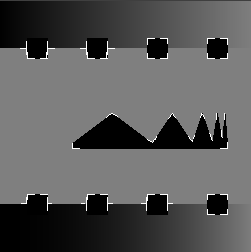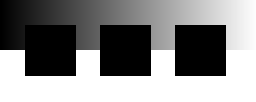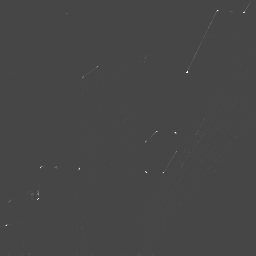

The algorithm was tested on synthetic and real-life images. The
synthetic images were designed so as to test the detector's ability to
cope with different angles, corner adjacency, gray-level distribution
and noise level [
8
]. Figure
6
a shows an original synthetic image. Figure
6
b shows its cornerness, and to which extent corners can be identified
for areas of low contrast. Figure
7
a shows the product as an edge detector. Figure
7
b shows the orientations of the corners found. The synthetic image on
figure
8
a was designed to estimate a measure of the accuracy of the detector.
The corners found on figure
8
b were, on average, less than half a pixel away from their theoretical
location, and their orientation was, on average, within a 1.5 degree
error range. The detector's ability to cope with noise is shown on
figure
8
c where a gaussian noise was added to the image before processing
(signal-to-noise ratio SNR = 20 dB). It shows that some corners and
junctions were missed, but the accuracy of the results remains good: the
corners' location is with a .5 pixel error range on average, and their
orientation is within a 2.1 degrees error range.
as an edge detector. Figure
7
b shows the orientations of the corners found. The synthetic image on
figure
8
a was designed to estimate a measure of the accuracy of the detector.
The corners found on figure
8
b were, on average, less than half a pixel away from their theoretical
location, and their orientation was, on average, within a 1.5 degree
error range. The detector's ability to cope with noise is shown on
figure
8
c where a gaussian noise was added to the image before processing
(signal-to-noise ratio SNR = 20 dB). It shows that some corners and
junctions were missed, but the accuracy of the results remains good: the
corners' location is with a .5 pixel error range on average, and their
orientation is within a 2.1 degrees error range.
To demonstrate the capacity of the algorithm to deal with real-life
images, we have applied it to a picture of a part of the Royal Festival
Hall, London, as shown on figure
9
a. The corners found are shown on figures
9
b and
10
a. The potential of the method for edge grouping is illustrated on
figure
10
b: a simple search algorithm joins corners with compatible directions to
obtain grouped contours of the objects.
 b)
b)
Figure 6:
a) Original synthetic image. The gradient ramp is linear on top of the
image, and quadratic at the bottom of the image. b) Cornerness c(
x
).
a) b)
b)
Figure 7:
a) Edge detector b) Orientations of the corners found. When the angle is narrow, one
direction only is given. Note that junctions are also identified.
b) Orientations of the corners found. When the angle is narrow, one
direction only is given. Note that junctions are also identified.
a)
b)
c)
Figure 8:
a) Original synthetic image. b) Orientation of the corners detected. The
positions found are on average less than half a pixel away from the
theoretical location, and the orientation error is on average less than
1.5 degree. c) Orientation of the corners found on the same image with
added gaussian noise (signal-to-noise ratio SNR = 20 dB). Some corners
are missed, but the accuracy of the measures found remains good
(location error less than .5 pixel; orientation error less than 2.1
degrees)
a) b)
b)
Figure 9:
a) Original image of a part of the Royal Festival Hall, London. b) Cornerness
c(
x
).
a) b)
b)
Figure 10:
a) Orientations of the detected corners. On a curved corner, the
tangential direction is given. b) Joining corners with compatible
directions. The knowledge of the orientations of the corners makes
grouping edges easy.



F. Chabat